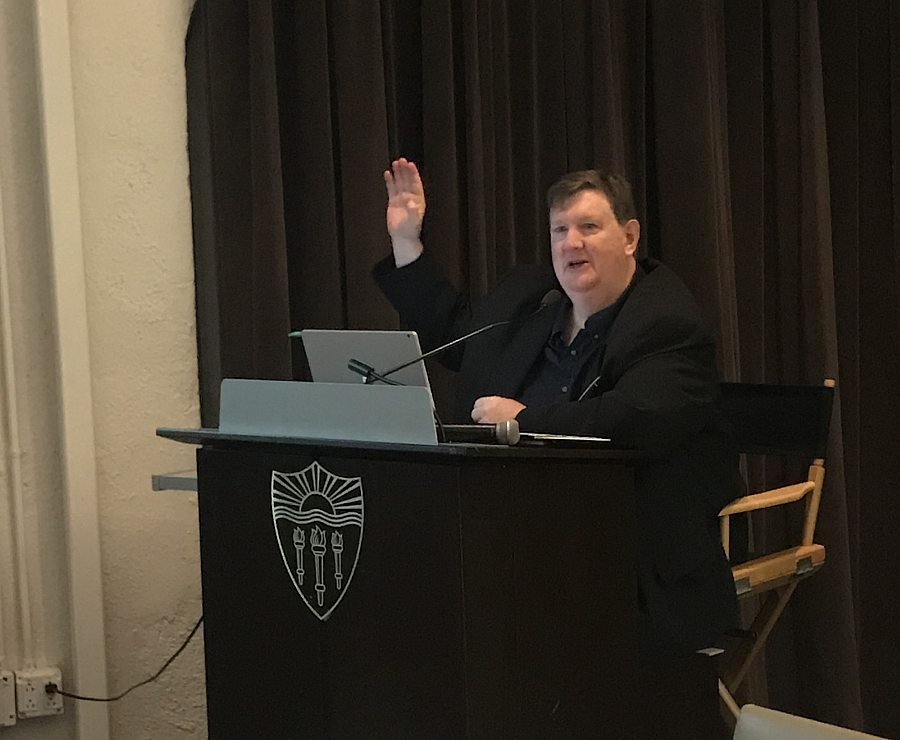Investigative veteran Mike Berens sees stories in every grain of sand, and finds the numbers to make others see them, too

Mike Berens delivers the keynote address at the 2017 California Date Fellowship on Wednesday.
Michael Berens sees stories everywhere. The Pulitzer Prize-winning investigative reporter spots them in in-flight magazines, buried footnotes, Inspector General reports, seemingly crazy letters from readers, offhand comments from cops. He spots the seeds of stories the way an infrared camera picks up heat sources.
But Berens, who returned to The Chicago Tribune in 2015 after an award-studded decade spent at The Seattle Times, is quick to point out that not all story ideas germinate into the kind of deeply reported data-driven investigative projects that have defined his career. He subjects story ideas through a rigorous 10-point checklist before diving deep. Sample criteria: “Is there a unique source of new information?” and “Is there potential for change or reform?”
But as Berens told fellows in his keynote talk Wednesday at the 2017 California Data Fellowship, the potential for data is king. “The secret ingredient in stories for me is: Can I quantify the issue in a way that has never been quantified before?” he said.
Berens doesn’t approximate either. He doesn’t want his stories to say there were “more than 1,000 deaths,” for example. He wants them to say there were 1,246 deaths. Berens says it’s that meticulous level of precision that makes the stories far more impactful — another item on his checklist.
“You can do really powerful stories that are going to be really attention-getting with the simplest listing and grouping and counting in Excel,” Berens said.
Berens shared some of the “tools” in the toolkit that he routinely uses for identifying the leads that turn into months-long investigative journeys. They include:
- “Read the footnotes. Boring reports can reap incredible findings.” Amazing nuggets are often hiding in plain sight. Pick an agency that impacts your area and see what kind of oversight reports you can find.
- For example, get familiar with Inspectors General reports. “Their job is essentially to be investigative reporters and ferret out corruption or things that need to be changed,” Berens said, and story ideas abound in the footnotes and source links of these reports.
- Make use of patient-level discharge data. In 13 states, this data is publicly available (here’s the link for California, for example). “I call it a database of 1,001 stories,” Berens said. You can ask the data questions like: “How many people from nursing homes are hospitalized each, for what and how long?” or “How many times did a surgeon leave a sponge in the body, or cut off the wrong limb?”
- The Office of Inspector General exclusion reports are another of Berens’ “secret weapons.” These reports offer lists of businesses and providers banned by the federal government from collecting federal money. What health care providers have been banned in your area? How many doctors have been banned or sued?
As valuable as these reports and databases have been to Berens’ work, he also strongly urges journalists to consider building their own databases when they can’t find or obtain the data they need. “If you ask me in my whole career what’s been my secret weapon, it’s not that I found some database gem sitting on the web or something obscure in the federal government,” he told fellows. “It’s been because I made my own database.”
That’s what Berens and Patricia Callahan did for their 2016 special report, “Suffering in Secret: Illinois hides abuse and neglect of adults with disabilities.” As the two write in the story, “state files were so heavily redacted and unreliable that the newspaper had to build its own databases by mining state investigative files, court records, law enforcement cases, industry reports, federal audits, grant awards and Medicaid data.”
But such deep investigations into byzantine worlds of bureaucracy and secrecy require more than reliable data. One of the recurring lessons of Berens' work is the importance of finding what he affectionately refers to as “the man in the basement.” That’s the guy or gal who knows more about your chosen topic than anyone else and can serve as your de facto guide and historian. “There’s always someone who had dedicated their life to exposing the problem you’re looking into,” Berens said. “Find them.”
In the case of Berens’ Pulitzer-winning series on methadone deaths in Washington state, his “guy in the basement” arrived via a forbiddingly dense letter from a Seattle-area doctor. Buried amid the obtuse jargon, the doctor was essentially informing Berens that the state of Washington was steering patients towards methadone because it was cheap and ignoring the mounting fatalities that ensued.
It was a letter Berens could have easily tossed into the “crackpot” pile, but instead it led to “Methadone and the Politics of Pain,” which garnered Berens and Ken Armstrong the 2012 Pulitzer for investigative reporting and led to major changes in the state.
“Don’t discount something that seems too dense,” Berens counseled. “Don’t discount something that seems too crazy.”
*

